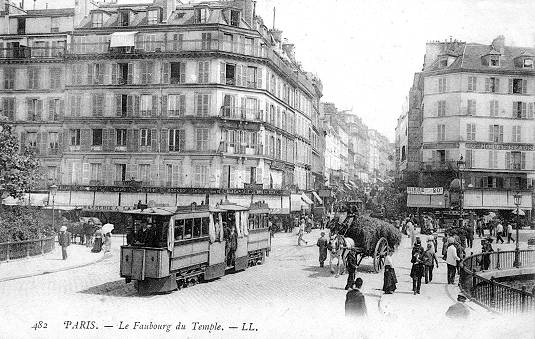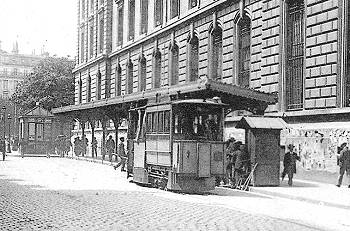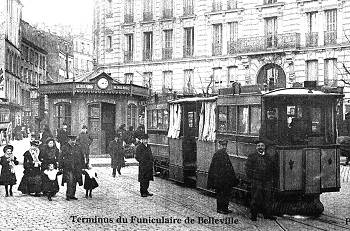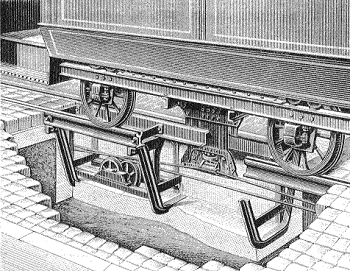

This postcard, which has an undivided back, was published by Lévy Fils et Cie, of 44 Rue Letellier, Paris about mid-1903 or earlier. It shows the funicular tramway which operated at that time to serve the district of Belleville, which lies to the north-east of the Paris city centre. The view is located in the Rue du Faubourg du Temple at the point where it crosses the Canal St. Martin. The two smaller views are extracts from postcards by unknown publishers.
 The metre gauge line was just over 2km long and ran from the Place de la Republic (left) to the church of St. Jean-Baptiste in the Belleville district (below right), climbing a hill most of the way but with a maximum gradient of 7 percent at the Belleville end. The tramway followed the Rue du Faubourg du Temple and the Rue de Belleville. The road was and still is very narrow, today it is one-way. Because of this the tramway was single track with passing loops, these being located at the Canal St. Martin, Avenue Parmentier, Boulevard de Belleville, Rue Julien-Lacroix and Rue des Pyrénées. There were double tracks at both termini, where there were also passenger shelters. The depot, offices and winding house were close to the Belleville terminus at 101 Rue de Belleville. The tramway was crossed at three junctions by other tramways, these being powered by electricity, steam and compressed air.
The metre gauge line was just over 2km long and ran from the Place de la Republic (left) to the church of St. Jean-Baptiste in the Belleville district (below right), climbing a hill most of the way but with a maximum gradient of 7 percent at the Belleville end. The tramway followed the Rue du Faubourg du Temple and the Rue de Belleville. The road was and still is very narrow, today it is one-way. Because of this the tramway was single track with passing loops, these being located at the Canal St. Martin, Avenue Parmentier, Boulevard de Belleville, Rue Julien-Lacroix and Rue des Pyrénées. There were double tracks at both termini, where there were also passenger shelters. The depot, offices and winding house were close to the Belleville terminus at 101 Rue de Belleville. The tramway was crossed at three junctions by other tramways, these being powered by electricity, steam and compressed air.
 A proposal to build the line had been made by a Monsieur Fournier in 1886, a decree to construct the line was granted on 24th January 1889 and a contract to build it was signed on 7th August 1890 by the Seine Department, with the city of Paris building the line under the guidance of its chief engineer, Fulgence Bienvenüe (better known as the "Father of Paris Metro"), and M. Fournier as its operator. Operation was passed to the Compagnie du Funiculaire de Belleville. The tramway opened on 25th August 1891. Fares were cheap at 10 centimes, with a half price workman's ticket available for an hour in the morning and evening. Trams ran about every six minutes for most of the day, the single journey taking around 15 minutes.
A proposal to build the line had been made by a Monsieur Fournier in 1886, a decree to construct the line was granted on 24th January 1889 and a contract to build it was signed on 7th August 1890 by the Seine Department, with the city of Paris building the line under the guidance of its chief engineer, Fulgence Bienvenüe (better known as the "Father of Paris Metro"), and M. Fournier as its operator. Operation was passed to the Compagnie du Funiculaire de Belleville. The tramway opened on 25th August 1891. Fares were cheap at 10 centimes, with a half price workman's ticket available for an hour in the morning and evening. Trams ran about every six minutes for most of the day, the single journey taking around 15 minutes.
 The track was laid in Broca rail and included a centre 29mm slot edged by "Z" sections held in place by "U" shaped yokes braced to the running rails and forming a conduit. A 29mm cable made of six steel strands round a hemp centre was carried on small 320mm diameter pulleys, 521 of them in all, set at 9 to 12 metres intervals and with traps to provide maintenance access. At each terminus the cable passed round a horizontal 2.5 metre diameter pulley. At the winding house the cable was diverted away from the tracks, trams dropping the cable as they passed. The trams were manually manoeuvred into the depot. As in the system in use in San Francisco today, each tram had a gripper (left) worked by levers, which could be attached or detached from the cable to provide control. The cable and hence the trams ran at 11 kph in the daytime and 13 kph in the evenings when road traffic was lighter. The winding house contained two Corliss 50 hp horizontal cylinder steam engines supplied by E.Garnier of Paris. These turned a shaft at 60 rpm, which in turn was reduced by gears to a 23 rpm shaft carrying a 2.5 metre pulley which pulled the cable via a system of pulleys forming a cable tensioner.
The track was laid in Broca rail and included a centre 29mm slot edged by "Z" sections held in place by "U" shaped yokes braced to the running rails and forming a conduit. A 29mm cable made of six steel strands round a hemp centre was carried on small 320mm diameter pulleys, 521 of them in all, set at 9 to 12 metres intervals and with traps to provide maintenance access. At each terminus the cable passed round a horizontal 2.5 metre diameter pulley. At the winding house the cable was diverted away from the tracks, trams dropping the cable as they passed. The trams were manually manoeuvred into the depot. As in the system in use in San Francisco today, each tram had a gripper (left) worked by levers, which could be attached or detached from the cable to provide control. The cable and hence the trams ran at 11 kph in the daytime and 13 kph in the evenings when road traffic was lighter. The winding house contained two Corliss 50 hp horizontal cylinder steam engines supplied by E.Garnier of Paris. These turned a shaft at 60 rpm, which in turn was reduced by gears to a 23 rpm shaft carrying a 2.5 metre pulley which pulled the cable via a system of pulleys forming a cable tensioner.
The trams were very small, being just 5 metres long and 1.6 metres wide. Each had longitudinal seats inside for 12 passengers and carried 5 more on each platform. There were 21 such cars. Apart from the gripper, they had hand brakes on the wheels and track brakes. After a runaway accident in 1906, they were also fitted with an automatic axle mounted centrifugal operated brake to limit speed. At first, trams were released in groups which followed each other and shared the passing loops. This practice was soon perceived as dangerous, so the cars each received an extended platform at one end over the couplings, and were then operated coupled together in pairs. In this form each they carried 57 passengers. They were unheated, but were lit with acetylene lamps.
Wear on cables was considerable and they rarely lasted more than six months. Breakage of strands would cause damage to pulleys and grippers and would bring the service to a halt. But despite this, revenue was high due to low fare and high usage with over 5 million passengers in 1902. In 1910 the concession ran out and operation of the tramway was taken over by the city. As mentioned above there was a runaway in 1906. On 6th January a gripper broke and the tram ran the whole length of Rue de Belleville. According to press reports it crossed Rue des Pyrénées at an unlikely 120 kph before the leading car derailed at the passing loop after crossing into Rue du Faubourg du Temple. There were 17 injuries reported. There were also accidents in 1907 and 1909 when cars failed to stop in time at the junction with Rue des Pyrénées and collided with Mékarski compressed air trams that were crossing. Operation continued with little change throughout the Great War although suffered considerable wear due to lack of maintenance. There was an interruption of service on 18th July 1924 when the trams were replaced by Schneider buses on Route BF, at first temporarily, but this became permanent and the following year the tramway was dismantled. Since 1935 part of metro line 11 has followed the same route, albeit underground.
![]() Go to Postcard Of The Month Index
Go to Postcard Of The Month Index